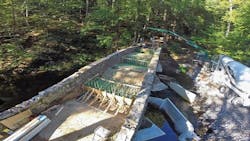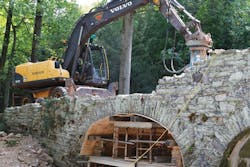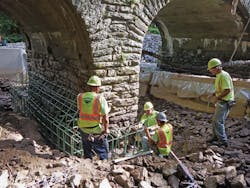Treated like family
How do you rehabilitate a 100-year-old masonry arch bridge without impacting its natural aesthetic?
Factor in that the bridge is the only access point for a 50-acre family property. These were the challenges of the Thompson family, owners of the Furness Bridge and descendants of Philadelphia architect Frank Furness and influential Shakespearean scholar, Horace Howard Furness.
The 60-ft Furness Bridge spans Ridley Creek on the charming grounds of the former Upper Bank Nursery in Media, Pa. With one of the bridge’s three arch spans partially collapsed, the Thompson family required immediate engineering expertise to ensure their safe passage, as well as that of any emergency vehicles. Additionally, the family needed a design that would preserve the appearance and legacy of the bridge and its picturesque setting.
Moving fast for emergency vehicles
Pennsylvania is home to one of the largest inventories of stone-arch bridges in the U.S. The arch form is both functional and aesthetic and was the natural bridge of choice for early settlers, remaining popular into the early 20th century. The Furness Bridge, built in 1916 by Fairman R. Furness, the Thompson family’s great uncle, was no exception. The bridge consists of two 16-ft spans and one 20-ft center span. With an overall length of just under 100 ft, the bridge features elliptical concrete-arch barrels and stone masonry spandrel walls, piers and abutments. The use of unreinforced concrete for the arch rings, instead of stone masonry, reflected the country’s shift in building-material preference during the period. Fairman Furness, founder of the Upper Bank Nursery, was a charismatic artist, horticulturist and lecturer. After serving as Third Secretary to the U.S. Embassy in Russia, he would return home in 1910 to purchase the 50-acre farm which he described as “the promised land.” Amongst perfectly manicured topiaries, Fairman’s bridge also served as a focal point of the nursery entrance to receive his distinguished client base. Among them was Pierre duPont. Furness forged a close relationship with DuPont, and would supply exotic plants for his personal estate now known as the world-class Longwood Gardens in Chadds Ford, Pa.
Within the last two years, members of the Thompson family sought to develop three of the five lots at the exclusive location. But before this plan could progress, the family had to be sure that the nearly 100-year-old bridge could support the weight of construction vehicles needed to install 600 ft of access roadway to the lots. In November 2014, Pennoni was contacted to perform an in-depth inspection and load rating of the bridge. The findings from the preliminary inspection revealed settlement and rotation of the east abutment leading to transverse cracking and failure in the adjacent Span 3 arch ring. A partially paved bridge roadway also allowed excessive water penetration and lateral spread of the fill material during winter months. The repeated freeze-thaw cycle had accelerated the rotation and movement of the abutment and north spandrel wall. Scour and undermining of the piers and abutments also were of significant concern. To assist with recommendations for repair, Pennoni next completed a geotechnical investigation at the bridge piers and abutments. With no existing bridge plans available, high-definition laser scanning was utilized to capture the essential 3-D bridge geometry and site topography. The end result of the HD laser scan was a 3-D point-cloud scale model, yielding accurate and detailed design drawings. Not only did this reduce time recording dimensions in the field, but also it served as a historical record for the bridge.
An analysis of the bridge using the Modified Military Experimental Establishment (MEXE) Method resulted in a load posting of 5 tons, a capacity insufficient to sustain modern trucks and emergency vehicles. Developed in England, the MEXE Method provides an empirical basis for the evaluation of stone masonry and concrete-arch bridges. This approach takes into consideration parameters such as arch geometry and material, type of fill, mortar condition, and the size and orientation of observed cracks and defects. As the long-term strength of such bridges is often difficult to assess, the MEXE Method is a practical and cost-effective alternative to finite element analysis.
In addition to the three parcels planned for development, the family also occupied two existing homes on the land. They too relied on the bridge for access. Given the poor condition of the bridge and inability for fire and medical vehicles to access the occupied homes, the focus shifted to developing an accelerated bridge rehabilitation scheme. Additionally, the design would need to account for pedestrian access during construction. And last but not least, all of the above would need to be accomplished without impacting the aesthetics of the bridge.
Rehabilitation of the bridge was predicated upon the need for construction vehicles to safely cross it in order to build 600 ft of access road.
Turning it inside out
Based on the findings and needs of the family, Pennoni proposed a unique design—rehabilitate the bridge from the inside out by constructing a new bridge within the existing structure. Pennoni’s design would call for the removal of the roadway and earthen fill over the existing concrete-arch rings and masonry walls. The non-structural fill would then be replaced with a reinforced concrete slab made integral with two of the existing arch spans and masonry façade. The compromised third span arch ring required complete replacement. Additionally, design experts called for general masonry repointing and the restoration of the adjacent abutment and wingwall, which was progressively displaced from its initial geometry. Pennoni’s design also included a stream ford-style crossing to maintain pedestrian access for the family during construction. The crossing utilized standard PennDOT-approved details and doubled as an access route for construction vehicles and workers.
There were other design considerations as well. Pennoni’s bridge experts needed to determine if the existing stone masonry piers could support design vehicles. The increased superstructure load resulting from the use of a reinforced concrete slab also would garner attention. Geotechnical test borings were ordered and taken through the center of the masonry piers. The borings were used to calculate the strength of the piers, which were found to be adequate. They also revealed that competent bedrock underlaid most of the bridge.
A waterproof membrane to be placed on the proposed slab was included in the design to minimize water intrusion over the bridge and abutments. Additionally, the roadway design included the addition of a rolled asphalt curb to channel water away where there was previously no protection from intrusion. To facilitate utility installation for the new development, Pennoni included provisions for future gas, electric and communications lines to be encased beneath the new bridge deck.
Based on the findings and needs of the family, Pennoni proposed a unique design—rehab the bridge from the inside out by constructing a new bridge within the existing structure.
A rent in the third span arch ring discovered following earth fill excavation.
Undermining of the piers and abutments was observed during the initial inspection. To address this challenge, Pennoni designed waterline concrete aprons for the piers and abutments as an effective long-term scour countermeasure. The apron design called for keying into the relatively shallow bedrock, with removed material to be repurposed as additional scour and channel protection. Work within Ridley Creek, including cofferdams and center-bracing for the third span replacement, would require close coordination with the Pennsylvania Department of Environmental Protection (PADEP). Pennoni’s environmental scientists and engineers provided the PADEP with detailed drawings. Design elements were arranged to minimize and avoid regulated resources. Erosion and sediment pollution-control plans also were developed for the agency’s review. Regular communication and strong relationships with regulators proved to be a key element in meeting the project-permitting schedule. The end result was PADEP approval of a GP-11 permit in less than 30 days. Permitting for the temporary ford crossing also was approved prior to contract bid preparations. These permit approvals also ensured that the project would hit the necessary construction timetable and avoid in-stream time-of-year restrictions associated with Ridley Creek, a trout-stocked fishery.
Pennoni remained actively engaged with potential contractors throughout design. Three contractors were invited to review Pennoni’s design and to express interest in the construction. The design was then refined based on the contractor’s constructability feedback and the need to stage construction to maintain pedestrian access for the Thompson family. Special provisions to maintain bridge aesthetics also were included in the contract documents. Details for cleaning and repointing the stone masonry were developed based on PennDOT standard specifications. Pennoni also called for a mortar analysis and field test panel to ensure matching of new stone masonry elements with those existing.
The concrete arches revealed.
Workers set a rebar skeleton for pier and abutment “aprons.”
Although price was considered, final contractor selection was based on qualifications, responsiveness during the invitation-to-bid period and approach to completing the project. Pennoni’s contract bid review phase culminated with the selection of specialty bridge contractor J.D. Eckman Inc. of Atglen, Pa., to perform the rehabilitation work. Eckman provided value in a competitive bid, and its approach also included pedestrian-friendly amenities such as temporary pick walkways for direct access over the bridge.
Final design was completed in under three months thanks to close collaboration with the Thompson family and the continuous collaboration between Pennoni’s bridge professionals, reviewing agencies and the contractors. Construction commenced in July 2015 and the bridge was on track to reopen by November 2015—approximately one year after initial concerns arose. Upon completion, the aesthetic of the Furness Bridge will have been preserved. The bridge will be able to support the weight of modern construction and emergency vehicles and will be capable of providing another century of service. R&B





